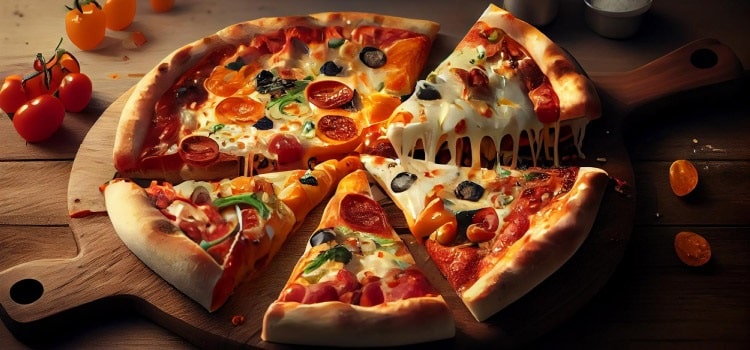A circular, flatbread with tomato sauce, mozzarella cheese, and as many different ingredients as the context dictates. Pizza is that and a journey from Naples to the world.
Pizza is a round or rectangular dough, with cheese or tomato sauce, pepperoni, or artichokes, that likes to play with contrasts: acidic, sweet, soft, crunchy, salty, and juicy. It was built on a thousand-year-old dough, adapted to the customs of the Romans, and was born definitively in the streets of Naples. Who could have imagined then that this survival recipe would catapult itself to world fame as one of the greatest delicacies in history?
Today, millions of books seek to unravel the secrets of its dough and recreate some of the most famous varieties: Margherita pizza, Neapolitan pizza, or the ever-controversial Hawaiian pizza. In this article, we try to humbly summarize everything that concerns its existence: what is pizza, what is its origin, what ingredients make it pizza, how many types exist and what is the best pizza in the world.
What is pizza
According to Antonio Criscitello, author of How to Make Pizza or Pizza, Focaccia, Torta, the Recipe Book, and a renowned expert on the subject with more than twenty years dedicated to pizza, he is “the personification of a cuisine that knew how to make a treasure out of simplicity.” Pizza in its simplest form is a round dough made with flour, water, and salt, which sometimes includes olive oil. In its beginnings, it was aromatic and white until the tomato arrived from America. Since then, pizza has been covered with tomato sauce, mozzarella, and all the ingredients that are most readily available, mushrooms from Veneto in the north of Italy or anchovies from Sicily when we are in the south.
The role of the pizzaiolo, the artisan who is responsible for making and cooking pizza in a wood-fired oven, is recognized by UNESCO as the Intangible Cultural Heritage of Humanity. In other words, it is considered a tradition capable of creating a sense of identity and community, which makes us wonder, where does this leave pre-cooked pizzas for heating in the microwave?
We asked Nathan Mhyrvold and Francisco Migoya, authors of Modernist Pizza, considered a masterpiece on the subject. Mhyrvold, who has a PhD in Theoretical Physics and Mathematics, has worked closely with Stephen Hawking and Bill Gates. A man of fertile interest, he felt the need to put together a five-volume compilation of cutting-edge techniques, which he launched into the world under the name Modernist Cuisine. To create Modernist Pizza, he worked with Mexican chef Francisco Migoya, also co-author of Modernist Bread. Together with him and the rest of the team, they spent four years searching for the world’s pizzas, creating 1,000 recipes, doing hundreds of experiments, and visiting up to 200 pizzerias around the world.
Mhyrvold, originally from Norway, the country in the world that consumes the most frozen pizza per capita, urges us to visit the fjords instead of his table. And Migoya shares with us the fundamental question on which the work of Modernist Pizza was based: What is a pizza? Beyond the leavened dough and the commonly used, but not essential, tomato sauce and mozzarella, what makes a pizza a pizza?
Turkey’s bafra pita, Armenia’s lahmacun, and Alsace’s flammkuchen also include dough, tomato, and fresh ingredients and would never be called a pizza, the author muses. Similarly, Migoya says, the work of the famous Roman pizza maker Gabriele Bonci is more like a focaccia-style dough with toppings added after the fact than the current definition of pizza and is instead called a pizza.
Pizza is not just a technical or etymological definition, but a compendium of ingredients, preparations, and historical lineage. A journey that includes migratory leaps from Naples to Buenos Aires, New York, or Chicago, where it became one of the most consumed and traditional foods in each locality. Its worth is recognized in world championships and festivals. But how do you decide which is the best pizza in the world after centuries of tradition?
Origin and history of pizza
Pizza was originally a dish for transporting food. The Roman poet Virgil described it in his epic poem Aeneid from the 1st century BCE as “trays for transporting food, which perfectly accommodate meat and fat, and which are also edible.” It was a thick version more similar to focaccia.
Virgil himself describes two ways in which this focaccia dough was prepared: either by mixing flour, water, herbs, and salt, kneading it for a long time, forming it into a circular shape, and flattening it before baking; or by mixing in all the spices, coriander, salt, pepper, fennel seeds, cheese and garum (the Roman fish-based sauce) and gently spreading it over the dough, in a similar way to how we would do today with tomato, cheese and the rest of the ingredients.
The white pizza
Centuries later, during the Renaissance, pizza was understood as nothing more than a disk of dough, about a finger’s width high, baked in an oven and used as a base for any type of filling. There is also a record of a type of pizza made with flour, egg, butter, sugar, and fried, which is much more reminiscent of the dessert category.
The version with salty dough seasoned with garlic, lard, and salt was the most popular in southern Italy. The lard was replaced by olive oil and a dough topped with cheese and aromatic herbs, in a rebirth of Virgil’s pizzas. This variety is known as white pizza or pizza alla mastunicola and is considered the original version of pizza.
A pizza that would stop being white around 1700 when the tomato from America landed in the Naples area. Just in time to witness the expansion of one of the most valued Neapolitan specialties: buffalo mozzarella. Hand in hand, buffalo mozzarella, and tomato sauce crowned the pizza, becoming the essential concept of today. Towards the end of the 1800s, Pellegrino Artusi already compiled in his masterpiece, La scienza in cucina e l’arte di mangiar bene, not only pizza but also pizza a libretti, a folded, fried, and edgeless shape intended for those who wanted, or had no other alternative, than to take it in one bite between walks.
The first modern pizza
The French explorer and playwright Alexandre Dumas, who was fascinated by this dish, spoke a lot about how and what the way of eating pizza showed. He observed during his travels to Naples in 1835 that pizza was the basic sustenance of the poor and workers, breakfast, lunch, and dinner. The ingredients used on it told of which had been the most profitable harvests that year and how well-off the town was. A fact highlighted by Dario de Marco, author of the essay “Alla ricerca della pizza perfecta”, a journey about pizza as an identity sign, who delves into the concept of pizza as street food, and asks: What else could it be, but street food, when this preparation was born in an era in which having a kitchen at home was a luxury?
The first modern pizza with ingredients other than tomato is believed to have been depicted in a Neapolitan cookbook in mid-1858. At that time, it was already framed under the motto “the true Neapolitan pizza” and it was pointed out that it was possible to use any condiment that was within reach. In that same cookbook, such modern possibilities as pizza all’aglio e olio, with basil, with prosciutto or with pomodoro appeared.
Who invented pizza?
Pizza was invented by those who needed to fill their stomachs in times when flour, cheese, and other ingredients from the countryside were the most affordable option. What had been happening since ancient times took definitive form in Naples in the mid-nineteenth century, which is why a fable about its origin was born that included pizzaiolos, royalty, and Naples.
Legend has it that Raffaele Esposito, a chef from Naples, was the inventor of pizza. According to the story, in 1889 he received a special commission to cook for the Queen of Italy, Margherita. In his eagerness to please her, he created different pizzas, such as the Neapolitan marinara and a version without garlic, with tomato, mozzarella, and basil that, according to the myth, captivated the Queen, so the chef decided to name it pizza Margherita, in Spanish, pizza margarita.
The Umbra Institute’s Food Studies Centre in Perugia, Italy, has repeatedly confirmed that this is nothing more than a convenient story that allowed a divided Italy to be united in the 19th century. In any case, legends and fables do not detract one iota from the veracity of the worldly origins of pizza in Naples, world-renowned as its birthplace.
Essential ingredients of pizza
The basic ingredients of pizza are water, salt, yeast, and flour. They are used to make the dough: thin, thick, circular or square, with a thin centre and thick edges, short fermentation or long fermentation. As we can imagine, it is a fundamental part and can completely detract from the process or become a source of praise.
One example is the weight that Sartoria Panatieri’s pizza dough had in its ranking as the third-best pizzeria in the world in the Top 50 Global. According to its creators, Jorge Sastre and Rafael Panatieri, the recipe is based on their own personal taste and they consider that their dough “has no secret, only the use of local flour mixed in the way in which we find the balance that we like and its treatment as something living, taking care of it daily.”
We continue with the following layers to find an infinite number of combinations that range from tomato and mozzarella to traditional Italian sausages, and not only that. According to Francisco Migoya, co-author of Modernist Pizza, this variability occurs because “pizza is a food that lends itself to innovation and creativity. It is, at the same time, the evolution of a 19th-century Neapolitan dish and a window open to originality. Proof of this is Franco Pepe’s pizza with canned tuna, mascarpone, and celery or Sarah Minnick’s Lovely’s Fifty Fifty with nectarines, sweet corn, leeks, bacon, and Niccolo cheese.” In light of this wide range, we compiled characteristics and qualities of the most commonly used ingredients.
Water
Simple. Water may seem like a simple and unimportant ingredient when we talk about pizza. The creaminess of the sauce, the melted cheese, the artichoke or the anchovies come to mind much earlier. So, why water? Water is the fundamental ingredient capable of turning the dough into a compact and raw piece of dough or into a tender, flexible, and juicy morsel. Each type of flour has a percentage of absorption that must be taken into account when adding water. As soon as water and flour come into contact, enzymes, molecules that act like scissors, go into action to convert starch into simpler sugars. These sugars will be the food for the yeast, so without them (and sometimes the extra help given with some sweetener) the dough would not rise. In addition, water also promotes the synthesis of gluten, which will appear in greater or lesser quantities depending again on the type of flour. Gluten has had a bad reputation in recent decades, but that doesn’t mean it’s still a key element in creating elastic and tender doughs. For this reason, it’s essential to highlight the importance of water in the existence of pizza.
Yeast
Saccharomyces cerevisiae is the scientific name for the yeast we use to make bread and pizza dough. Presented in the form of a cream, in the form of a compact fresh tablet or dehydrated in commercial sachets, yeast is synonymous with fluffiness. With its mere presence and by feeding on the sugars in the flour, it releases the gases responsible for those bubbles, of smaller or larger size, that give tenderness to each piece of bread. For many dough artisans, the best way to let it act is for long periods of more than ten hours. In this way, a more complex, aromatic flavour is achieved and other bacteria present in the flour can take part.
Flour
Daring to simplify, we can divide flours into two large groups: the whiter and finer flours and the wholemeal and dark flours. The latter have a much better reputation for health. They are associated with low glycemic peaks, with a higher amount of fiber, and the only drawback for a baker or pizzaiolo is that they are also harder and more difficult to leaven. On the other hand, the whiter and finer the flour, the easier it is to knead, it absorbs water, and its sugars are easily cut, so leavening is always successful.
Salt
Salt only makes up 1% or 5% of the total ingredients in a pizza, but it is essential to ensure that eating it is a positive experience and does not lead to food poisoning. As Dario de Marco reminds us, salt is responsible for keeping away pathogenic bacteria during the leavening process. This is essential protection when the dough in question needs to leaven for many hours or even days. It also contributes to the synthesis of gluten, which is why salt is essential for the structure of the dough. However, it must be included at the right time: towards the end of kneading, so that it does not interfere with the proper functioning of the yeast or support the development of gluten so much that it turns the dough into a rigid agglomerate. Salt is the perfect ally, at the right time.
Tomato
The tomato, as we read, is brought from America, and is used in the form of a sauce just before baking the pizza. This is the way to avoid excessive humidity that would alter the dough and to achieve the exact level of acidity that will contrast with the fat of the cheese and the saltiness of the condiments.
Mozzarella
There are different types of mozzarella: mozzarella made from cow’s milk, buffalo mozzarella made from milk from the female water buffalo, or mozzarella fior di latte made from cow’s milk. The latter, soaked in water and whey, is too watery to be used on pizza, so less watery varieties with a slightly lower percentage of fat than mozzarella intended for fresh consumption are always chosen.
Cheeses
Only one decision separates us from having the fattiest and juiciest cheeses of Italian cuisine with our pizza. Provolone, Sorrentino, ricotta or Pecorino Romano, which was brought to Sardinia for historical reasons, are some of the cheeses used in vegetarian pizza versions where they help to enhance the contrast of the vegetables with their saltiness. Among the most recent trends, burrata pizza with truffle has managed to attract attention and media attention.
Italian sausage
Prosciutto, ham, and salami piccante, a spicy pork sausage, are emblematic ingredients for Italian pizza. Lonzino, a sausage made from pork loin seasoned with salt, pepper, fennel, and wine, is also popular. Pepperoni, which has nothing to do with pepperoni, the Italian pepper, but with pepper, the English word for black pepper, which is used to season this sausage in the United States to achieve a result similar to that of Italian preparations, is also popular.
Vegetables: mushrooms, spinach, peppers and artichokes
Mushrooms accompanied by green and black olives top the capricious pizza. Spinach joins provolone from northern Italy or pine nuts, raisins, and Parmigiano for a salty and contrasting combination. Peppers are the protagonists of the pizza ai peperoni, which should not be confused with the American pepperoni pizza that refers to the spicy sausage, but with the recipe with colored peppers accompanied by scamorza cheese, onion, and a little basil. Artichokes are another iconic vegetable that is used alone on the bed of tomato and cheese.
From the sea: anchovies and tuna
Anchovies, whether from Sicily or northern Liguria, are served on a bed of mozzarella and a pinch of pecorino on the classic Sardinian pizza. On the other hand, tuna, also caught in Sicily, Sardinia, and Liguria, is another of the most popular seafood ingredients on Italian pizzas, whether accompanied by onions or olives.
Types of pizza in Italy
A tour of the main Italian pizzas is to get closer to their origins and their expansion adapted to the gastronomic landscape of each region. Starting with those who did not yet know mozzarella and going on to anchovies from the south and north. Pizza with seafood, pepperoni, gorgonzola, salmon, tuna, Bismarck, turnip tops, capricciosa, with asparagus, sardines, endive, Tuscan, vegetable, Margherita, poor, four seasons, Sardinian, Sicilian…
Neapolitan pizza
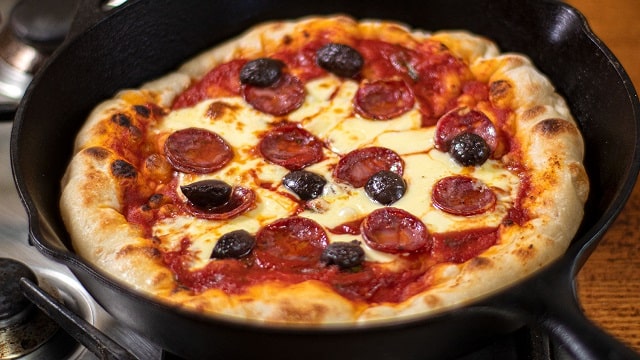
The term Neapolitan pizza covers the thin-crust specialties of Naples in which the air is directed towards the edges, creating a thin crust in the middle and thick and crispy at the edges. Tomato is added to make it marinara and tomato, mozzarella, and basil for the margarita.
Marinara Pizza
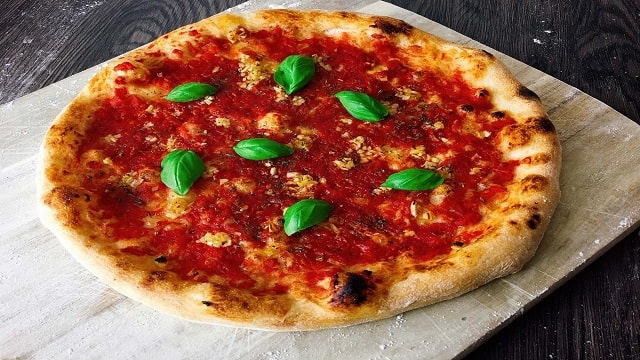
Oil, oregano, garlic, and tomato are what make up the pizza marinara from the Neapolitan region. It is no mistake to associate it with the sea, since it once fed sailors and fishermen, which is why its name retains this name, even though it does not contain fish among its ingredients.
Margherita Pizza

According to Pizza: A Global History, the Margherita pizza is the only other variety that can be considered 100% native to Naples. It is tomato-based and does not contain garlic, but does contain aromatic basil and mozzarella cheese.
Capricciosa pizza
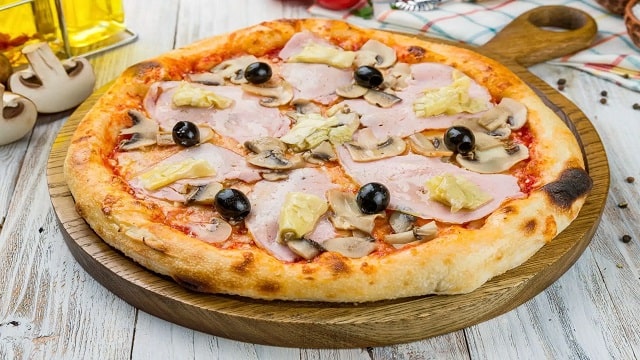
With the presence of black olives, the Capricciosa pizza is one of the most famous in the world. Depending on the season, we can also find it with artichokes and even mussels if we are on the southern coast of Italy. A very versatile variety adapted to each region.
Bismarck Pizza

Fried eggs. This is the ingredient that sets Bismark Pizza apart from the rest. The reason is curious. According to some sources, adding fried eggs to pizza was born from the Count’s preference for eating them daily at a time when they represented energy and success.
Tuscany Pizza

Against all odds, the Tuscan pizza recipe that has been included in so many recipe books over the last ten years stands out for its use of Swiss Gruyere cheese. This contrasts with the invention of Gabrielle Dani, an expert Tuscan pizza maker who created his own version of Tuscan pizza, creating the “picicaccia”, a fusion of Tuscan schiacciata and a series of ingredients from the region such as guancia and San Miniato truffle.
Sardinian Pizza
Anchovies are the hallmark of southern pizzas. Sardinian pizzas are undoubtedly rich in anchovies, which are usually topped with mozzarella cheese and sometimes with potatoes seasoned with oregano.
Sicilian Pizza
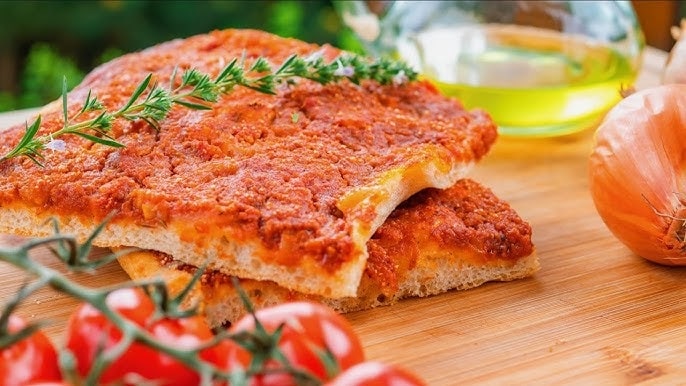
In the Sicilian version, anchovies are accompanied by capers. Depending on the version, black olives, peppers and eggplant are also added. If it is from the province of Palermo, in addition to capers, breadcrumbs and caciocavallo cheese are also added. In Catania, however, pizza has taken a different direction, becoming more like a type of calzone, but filled with anchovies and cheese.
Types of pizza in the United States
Which came first, Italian pizza or American pizza? According to author Carol Helstosky, pizza’s great expansion throughout Italy came after it landed in the United States by Neapolitan migrants, specifically in New York or New Haven. Based on certainty or perception, what is undeniable is that the American palate has a very clear idea of what its favorite pizza is. Adapted to different regions, American pizza specialties vary in thickness, sauces, and the way they are eaten.
California Pizza

California pizza is characterized by a thin, Italian-style crust, and according to American gourmets, it always includes fresher, more local ingredients than other styles. We are talking, for example, about peanut sauce and chicken, or fresh artichokes. Although its origin is also attributed to Ed LaDou and Alice Waters in the 1980s, the recipes with goat cheese or duck cheese by the chefs who worked with Waters herself were especially renowned.
Chicago Pizza
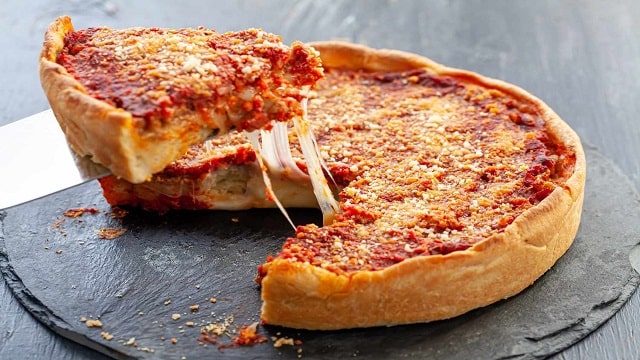
It might be a quiche, but it’s a pizza. The Chicago variety stands out above the rest for its considerable thickness . The crust is thin, and it encases tomato, mozzarella and filling as if it were a tartlet. Because of its height, it is also known as deep-dish pizza. It is common to fill its depth with minced meat, a kind of sofrito and serve it well covered with cheese.
Detroit Pizza
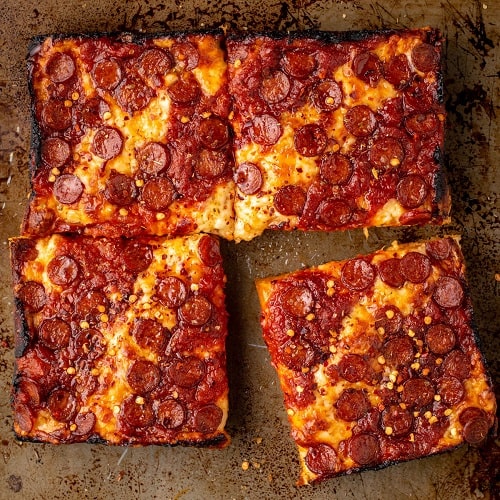
Square pizza. Inspired by Sicily, Detroit pizza took its square shape from Palermo, Sicily, keeping the thin thickness of less than a centimeter and a tomato and pepperoni topping in the most Italian style.
New Haven Pizza

Also known as tomato pie for its simplicity and finesse, the New Haven pizza was created in 1925 by Frank Pepe Pizzeria . It is round, with an oregano base, and tomato sauce, and of course, if it is not the simple one, it also has a pinch of pecorino in a pure connection with Italy.
New York Pizza
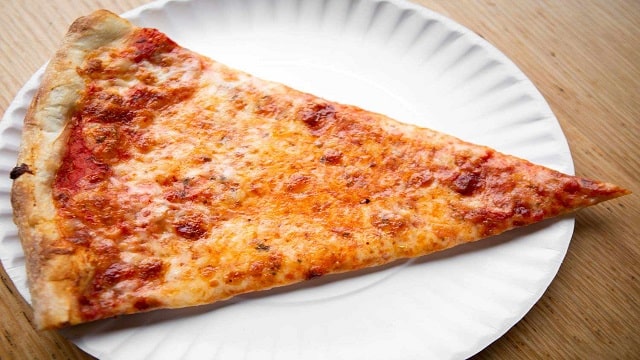
The thinnest crust for the biggest pizza. New York pizza has a large diameter that contrasts with its thinness. As one of the first to evolve with the Italian migration, it retains the simplicity of its origins and is usually presented with just tomato sauce and mozzarella cheese. It is the slice that one would expect in the hands of a New Yorker running up the street.
Types of pizza in Argentina
If Norway is the country that eats the most frozen pizza per capita, Argentina is the one that has the most pizzerias per inhabitant. It is impossible that Argentina, the great host of Italian immigration, was not the region that thus fulfilled its cultural heritage. In general terms, its style of pizza is striking due to the amount of mozzarella that covers the edges, with small differences between some of the most famous types.
Pizza court
This Argentinian pizza, similar to marinara, has a thin base and tomato sauce seasoned with garlic. It was the brainchild of Óscar Vianini, who dedicated himself to selling it at the exit of football matches, which is why he designed it with a diameter slightly larger than average.
Fugazzeta pizza
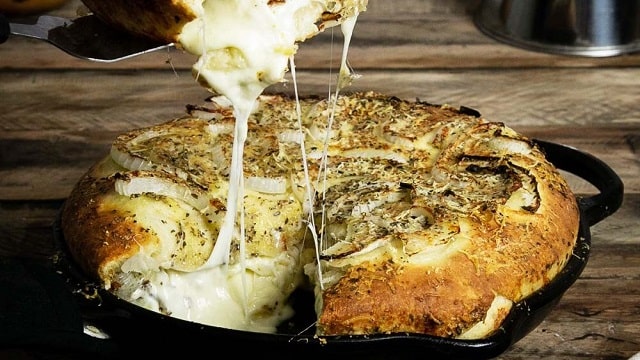
In Buenos Aires they created the pizza with cheese filling and onion topping. The invention was the work of Juan Banchero, son of a Genoese who was inspired by the Neapolitan pizza, with thin crust and simple topping, and the Genoese focaccia with onion, called “fugassa”.
The best pizzas in the world
The best pizza in the world? Migoya is clear that pizza is a very personal food for many people and that many stick to the style they grew up with. For the preparation of Modernist Pizza they were guided by Gambero Rosso, a renowned Italian restaurant guide. They managed to create uniformity in their palate by choosing to try the Margherita and the marinara in each of the pizzerias they visited around the world. Its simplicity allowed them to distinguish the preparation and quality of the ingredients. Secondly, they followed the local recommendation: In New York, the pepperoni, in New Haven, clam pizza and in Chicago, the sausage. The pizzeria Franco Pepe’s Pepe in Grani, in Caiazzo, or Massimo Laveglia’s L’Industrie Pizzeria in Brooklyn are among their favorites.
Closer to home, in Barcelona, we find Jorge Sastre and Rafael Panatieri in charge of Sartoria Panatieri, the third-best pizzeria in the world according to the Top 50 Global Pizza in 2023. They could have chosen any other dish, but they chose pizza. According to Sastre, the reason was Rafa’s Italian ancestry and the desire to “transform a product that was denigrated as fast food into a nutritionally balanced dish, made with quality ingredients and treated in the way we treated dishes and ingredients in the restaurants we had previously worked in.” Both received the award as a compliment for their choice of ingredients, from Solsona flour to homemade sausages, and their commitment to taking care of every step of the preparation, including fermentations of more than 48 hours to achieve an almost secret dough. They admit that it is a recognition of their daily work and that it has contributed to expanding interest, people from outside the city, from outside the area, are now turning their attention to Sartoria Panatieri.
Pizza recipes
To start talking about pizza recipes, one must delve into the fascinating world of its dough. Its elasticity, the play of different flours and the different fermentation times. Once the table is floured, we can set out to explore the classic Neapolitan pizza, be it the marinara or margarita version, the capricious one with olives and salty ingredients, the prosciutto pizza or the pepperoni pizza with spicy sausage, in the purest American style. Of course, today, there are many recipes that allow us to taste gluten-free versions. Doughs based on cauliflower or egg white or quinoa , to enjoy this dish and all the possible toppings suitable for celiacs and gluten intolerants.
And all this without forgetting those pizzas that are at home, especially in countries with Spain: barbecue pizza , pizza with minced meat and the always controversial Hawaiian pizza .
